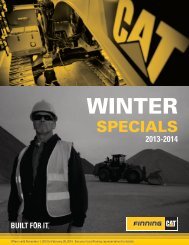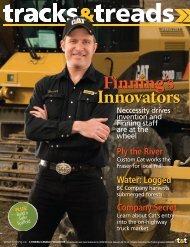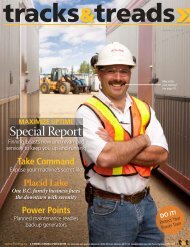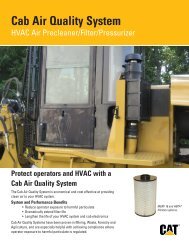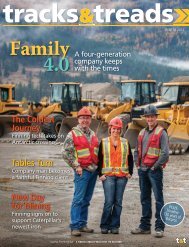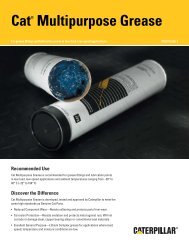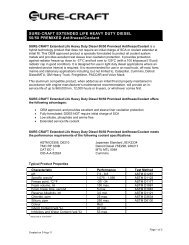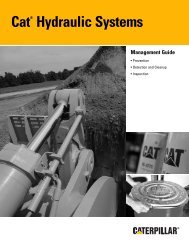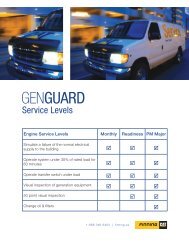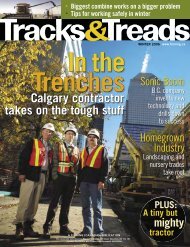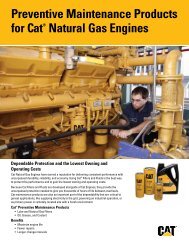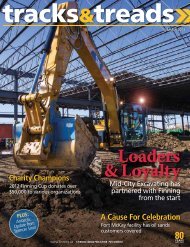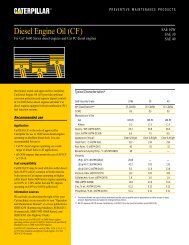Tracks and Treads - Finning Canada
Tracks and Treads - Finning Canada
Tracks and Treads - Finning Canada
You also want an ePaper? Increase the reach of your titles
YUMPU automatically turns print PDFs into web optimized ePapers that Google loves.
Yesterday/Today<br />
Story by keith haddock<br />
Affordable <strong>and</strong> versatile, the backhoe loader has evolved over<br />
the years <strong>and</strong> remains a vital tool on construction sites<br />
Still Digging<br />
For the past four decades, backhoe loaders<br />
have been the mainstay of mechanized<br />
utility work. Even with the advent of miniexcavators,<br />
the increasive popularity of<br />
skid steer loaders <strong>and</strong> number of companies<br />
making compact-sized machines, the<br />
backhoe loader has held its ground. It has<br />
become more versatile <strong>and</strong> has adapted to<br />
modern construction practices. It wins out<br />
over most other small digging machines because<br />
of its superior mobility: it can travel<br />
at highway speeds over short to medium<br />
distances.<br />
Towards the end of the 1970s, Caterpillar<br />
recognized the importance of the loader<br />
backhoe <strong>and</strong> the potential for even wider<br />
markets for this type of machine. Noting the<br />
success of pioneer builders, especially those<br />
in the United Kingdom, Caterpillar decided<br />
to add backhoe loaders to its product line. It<br />
started up an intensive development program<br />
to design <strong>and</strong> build its own machines. With<br />
production of loader backhoes assigned to<br />
Caterpillar’s plant at Leicester, Engl<strong>and</strong>, the<br />
wraps were taken off the first model, the 416,<br />
in 1985. In the 14-foot digging depth class,<br />
the 416 carried a 62-flywheel horsepower<br />
engine. Special features included a back-ofcentre<br />
carry position for the backhoe, which<br />
provided superior stability when travelling, as<br />
well as single cylinder bucket roll-back.<br />
By 1989, Caterpillar had exp<strong>and</strong>ed its<br />
backhoe loader line to six models ranging<br />
in size up to the 95-flywheel horsepower<br />
446, which offered a st<strong>and</strong>ard digging depth<br />
of 17 feet <strong>and</strong> up to 21 feet with its extended<br />
arm. Included in the line were two side-shift<br />
models, the 428 <strong>and</strong> 438. On side-shift models,<br />
the backhoe boom assembly is carried<br />
on a sliding frame so the boom pivot can be<br />
positioned at any point from the left to the<br />
DIG IN: Caterpillar’s first loader backhoe, the 416, proved that power was in the eye of the beholder<br />
right of the machine. This simple feature,<br />
more popular in Europe than in North America,<br />
allows the operator to dig flush to walls<br />
<strong>and</strong> footings <strong>and</strong> offers more flexibility when<br />
excavating around obstructions. The 428 <strong>and</strong><br />
438 could dig to 15 feet 9 inches <strong>and</strong> came<br />
with power units of 70 <strong>and</strong> 84-flywheel horsepower,<br />
respectively.<br />
Caterpillar refined its loader backhoe<br />
models with the introduction of the Series II<br />
models in 1990, then followed in 1992 with<br />
the announcement of the upgraded B-series.<br />
The B models sported a curved excavator-style<br />
backhoe boom, which first appeared on the<br />
original 446 in 1989. This design provided<br />
more clearance when digging over obstacles<br />
<strong>and</strong> a greater overall digging depth. The<br />
B models were also endowed with increased<br />
power to 74 flywheel horsepower for the 416B<br />
to 84 flywheel horsepower for the 436B.<br />
Keeping pace with the latest technology,<br />
in 1993 Caterpillar introduced its first<br />
loader backhoe with optional four-wheel<br />
drive <strong>and</strong> four-wheel steer on its side-shift<br />
438B model <strong>and</strong>, in 1996 made this feature<br />
available on certain models in its newly designed-series.<br />
Never allowing its designs<br />
to stagnate, in 2001 Caterpillar introduced<br />
the first of its D-series backhoe loaders: the<br />
420D <strong>and</strong> 430D. The entire D-series line,<br />
completed in 2004, with the introduction of<br />
the 446D at 102 horsepower, boasted pilotoperated<br />
joystick controls for ease of operation<br />
<strong>and</strong> increased backhoe bucket rotation<br />
to 205 degrees.<br />
Today, Caterpillar serves the loader backhoe<br />
market with its latest E-series, which<br />
comprises 10 sizes of machines available<br />
in different options, including tool carrier<br />
<strong>and</strong> side-shift models. They range from the<br />
78-horsepower 416E to the 137-horsepower<br />
450E. Affordable for even the smallest<br />
contractor <strong>and</strong> capable of performing a<br />
wide variety of jobs, the backhoe loader will<br />
continue to perform a vital role on construction<br />
sites for the foreseeable future.<br />
photograph courtesy keith haddock<br />
12 tracks & treads • Fall 2008 www.finning.ca



